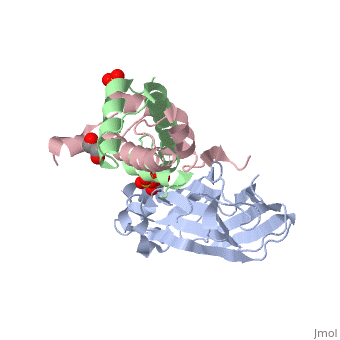Histone core protein structure
Histones are highly (more purple = more conserved) with (blue is positive charge, red is negative charge). Because of this positive charge, they interact electrostatically with the negatively charged phosphate groups in DNA.
There are five major classes of histones: H1/H5, H2A, H2B, H3, and H4.[1][2] Histones , , , and are known as the core histones, while histones H1 and H5 are known as the linker histones.
The 4 'core' histones (H2A, H2B, H3 and H4) are relatively similar in structure and are highly conserved through evolution, all featuring a motif (which allows the easy dimerization). They also share the feature of long 'tails' on one end of the amino acid structure, which are often covalently modified to regulate gene expression.
Histone interactions with DNA
Histones are the chief protein components of , acting as spools around which DNA winds, and play a role in gene regulation. Without histones, the unwound DNA in chromosomes would be very long; each human cell has about 1.8 meters of DNA, but wound on the histones it has about 90 micrometers (0.09 mm) of chromatin, which, when duplicated and condensed during mitosis, result in about 120 micrometers of chromosomes.[3] DNA is wrapped around nucleosomes with approximately 50 base pairs of DNA between subsequent nucleosomes (also referred to as linker DNA). The assembled histones and DNA is called chromatin. During mitosis and meiosis, the condensed chromosomes are assembled through interactions between nucleosomes and other regulatory proteins.
The nucleosome core is formed of two and a , forming two nearly by tertiary structure.[4] 147 base pairs of around this core particle 1.65 times in a left-handed super-helical turn.[4] The linker histone H1 binds the nucleosome and the entry and exit sites of the DNA, thus locking the DNA into place[5] and allowing the formation of higher order structure.
The chromatosome contains histone H1 binding to nucleosome. It contains 166 DNA base pairs.
In all, histones make five types of interactions with DNA:
- from alpha-helices in H2B, H3, and H4 cause a net positive charge to accumulate at the point of interaction with negatively charged phosphate groups on DNA
- Hydrogen bonds between the DNA backbone and the peptide bond in the backbone of histone proteins
- Interactions between the histone and deoxyribose sugars on DNA
- between side chains of basic amino acids (especially lysine and arginine) and phosphate oxygens on DNA
- Non-specific minor groove insertions of the H3 and H2B into two minor grooves each on the DNA molecule
In general, genes that are active have less bound histone, while inactive genes are highly associated with histones during interphase. It also appears that the structure of histones has been evolutionarily conserved, as any deleterious mutations would be severely maladaptive.
Chromatin regulation
Histones are subject to post translational modification by enzymes primarily on their N-terminal tails, but also in their globular domains. Such modifications include methylation, acetylation, phosphorylation, SUMOylation, ubiquitination, and ADP-ribosylation. This affects gene expression. The core of the histones H2A, H2B, and H3 can also be modified. Combinations of modifications are thought to constitute a code, the so-called "histone code".[6][7] Histone modifications act in diverse biological processes such as gene regulation, DNA repair, chromosome condensation (in mitosis, spermatogenesis, and meiosis).[8]
The common nomenclature of histone modifications is:
- The name of the histone (e.g., H3)
- The single-letter amino acid abbreviation (e.g., K for Lysine) and the amino acid position in the protein
- The type of modification (Me: methyl, P: phosphate, Ac: acetylation, Ub: ubiquitin)
So H3K4me1 denotes the monomethylation of the 4th residue (a lysine) from the start (i.e., the N-terminal) of the H3 protein.

